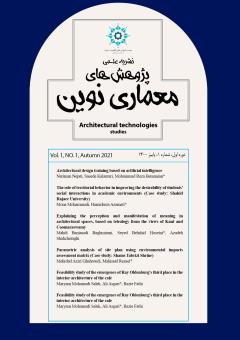Architectural design training based on artificial intelligence
Subject Areas : Artificial intelligence in architecture
Nariman Nejati
1
,
saeede kalantari
2
![]() ,
MohammadReza Bemanian
3
,
MohammadReza Bemanian
3
![]()
1 - PhD Student in Architecture, Department of Architecture, Faculty of Architecture, Islamic Azad University, Mashhad Branch, Mashhad, Iran
2 - PhD Student in Architecture, Department of Architecture, Faculty of Art and Architecture, Tarbiat Modares University, Tehran, Iran
3 - Professor, Department of Architecture, Faculty of Art and Architecture, Tarbiat Modares University, Tehran, Iran
Keywords: Artificial Intelligence, Architecture training, Architectural Design, Technology,
Abstract :
Rapid development of artificial intelligence (AI) technologies and the interest in their application in educational fields lead to significant growth in the scientific literature concerning the application of AI in education. Architectural design is a complex design that uses old experiences and creativity to produce new designs. The artificial intelligence use for the design process should not focus on finding a solution in a defined search space because the design requirements at the conceptual stage are not yet well defined. Instead, the artificial intelligence application should be considered to explore the design requirements and provide solutions to meet those requirements. The present applied study aims to provide an architectural design training model based on artificial intelligence in architecture education to provide an overview of artificial intelligence for the development and further implementation of the country's design education system. The type of this research is applied-developmental, and its method is descriptive-analytical and in terms of data collection surveys. A questionnaire was distributed among all faculty members of Azad University and experts in this field to collect the data required for the study. The collected data was analyzed by the method of content analysis. The results contain solutions to provide a model for architectural design training based on artificial intelligence. This study will acquaint professors and researchers to understand the status and development of financial and physical infrastructure and artificial intelligence hardware and software. Also, it will help increase the effectiveness and efficiency of its usage in architectural education. The findings also help activists, officials, educators, and researchers identify ways to improve designer education.
1. Chen, X., Xie, H., & Hwang, G. J. (2020). A Multi-Perspective Study on Artificial Intelligence in Education: Grants, Conferences, Journals, Software Tools, Institutions, and Researchers. Computers and Education: Artificial Intelligence, 100005.
2. Guan, C., Mou, J., & Jiang, Z. (2020). Artificial intelligence innovation in education: a twenty-year data-driven historical analysis. International Journal of Innovation Studies, 4(4), 134-147.
3. Serban, I. V., Gupta, V., Kochmar, E., Vu, D. D., Belfer, R., Pineau, J., ... & Bengio, Y. (2020, July). A Large-Scale, Open-Domain, Mixed-Interface Dialogue-Based ITS for STEM. In International Conference on Artificial Intelligence in Education (pp. 387-392). Springer, Cham.
4. Ralston, K., Chen, Y., Isah, H., & Zulkernine, F. (2019, December). A Voice Interactive Multilingual Student Support System using IBM Watson. In 2019 18th IEEE International Conference On Machine Learning And Applications (ICMLA) (pp. 1924-1929). IEEE
5. Roll, I., & Wylie, R. (2016). Evolution and revolution in artificial intelligence in education. Int. J. Artif. Intell. Educ., 26(2), 582e599
6. Popenici, S. A., & Kerr, S. (2017). Exploring the impact of artificial intelligence on teaching and learning in higher education. Research and Practice in Technology Enhanced Learning, 12(1), 22.
7. Lykourentzou, I., Giannoukos, I., Nikolopoulos, V., Mpardis, G., & Loumos, V. (2009). Dropout prediction in e-learning courses through the combination of machine learning techniques. Computers & Education, 53(3), 950-965.
8. Luckin, R., Holmes, W., Griffiths, M., & Forcier, L. B. (2016). Intelligence unleashed: An argument for AI in education.
9. Lucena, F. J. H., Díaz, I. A., Rodríguez, J. M. R., & Marín, J. A. M. (2019). Influencia del aula invertida en el rendimiento académico. Una revisión sistemática. Campus Virtuales, 8(1), 9-18.
10. Kandlhofer, M., Steinbauer, G., Hirschmugl-Gaisch, S., & Huber, P. (2016, October). Artificial intelligence and computer science in education: From kindergarten to university. In 2016 IEEE Frontiers in Education Conference (FIE) (pp. 1-9). IEEE.
11. Mair, J., & Reischauer, G. (2017). Capturing the dynamics of the sharing economy: Institutional research on the plural forms and practices of sharing economy organizations. Technological Forecasting and Social Change, 125, 11-20.
12. McKenney, S., & Mor, Y. (2015). Supporting teachers in data-informed educational design. Br. J. Educ. Technol., 46(2 SI), 265e279.
13. Martí‐Parreño, J., Méndez‐Ibáñez, E., & Alonso‐Arroyo, A. (2016). The use of gamification in education: a bibliometric and text mining analysis. Journal of computer assisted learning, 32(6), 663-676.
14. Miao, D., Dong, Y., & Lu, X. (2020). PIPE: Predicting Logical Programming Errors in Programming Exercises. In Proceedings of The 12th International Conference on Educational Data Mining (EDM 2020).
15. Mou, X. (2019, September). Artificial intelligence: investment trends and selected industry uses. https://www.ifc.org/wps/wcm/connect/7898d957-69b5- 4727-9226-277e8ae28711/EMCompass-Note 71-AI-Investment-Trends.pdf?MOD¼AJPERES&CVID¼mR5Jvd6.
16. Wang, W., & Siau, K. (2019). Artificial intelligence, machine learning, automation, robotics, future of work and future of humanity: a review and research agenda. J. Database Manag., 30(1), 61e79.
17. Roemer, R. C., & Borchardt, R. (2015). Altmetrics and the role of librarians. Library Technology Reports, 51(5), 31-37.
18. Russell, S., & Norvig, P. (2018). Artificial intelligence: a modern approach.
19. Tran, B. X., McIntyre, R. S., Latkin, C. A., Phan, H. T., Vu, G. T., Nguyen, H. L. T., ... & Ho, R. (2019). The Current Research Landscape on the Artificial Intelligence Application in the Management of Depressive Disorders: A Bibliometric Analysis. International Journal of Environmental Research and Public Health, 16(12), 2150.
20. Xing, W., & Du, D. (2019). Dropout prediction in MOOCs: Using deep learning for personalized intervention. Journal of Educational Computing Research, 57(3), 547-570.
21. Ye, J., Ding, H., Ren, J., & Xia, Z. (2018). The publication trend of neuropathic pain in the world and China: a 20–years bibliometric analysis. The journal of headache and pain, 19(1), 1-8.
22. Whitehill, J., Serpell, Z., Lin, Y. C., Foster, A., & Movellan, J. R. (2014). The faces of engagement: Automatic recognition of student engagementfrom facial expressions. IEEE Transactions on Affective Computing, 5(1), 86-98.


